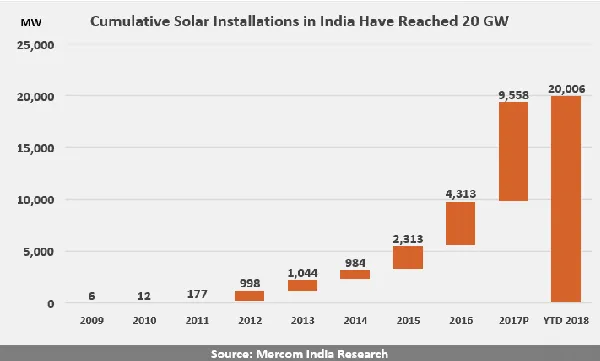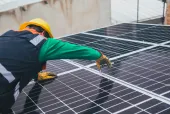
Sun's out, guns out: India's installed solar capacity hit 20GW
20GW capacity was initially set as a 2022 target.
India has achieved a milestone 20GW in cumulative solar installations to date, reports Mercom India Research based on recent figures. 20GW was the initial goal set up for 2022 by the National Solar Mission, which has been reached four years ahead of time. This demonstrates the commitment by the new government, which is working hard to achieve the revised target of 100GW solar by 2022.
According to Mercom’s India Solar Project Tracker, the utility-scale cumulative installations total for India now stands at ~18.4GW, with rooftop solar accounting for another ~1.6GW.
For the first time, solar was the top source of new power capacity additions in India during calendar year 2017, with preliminary figures gathered by Mercom showing that solar installations reached ~9.6GW and accounted for 45 percent of total capacity additions.
Here's more from Mercom India Research:
The top state for solar installations was Telangana, followed by Karnataka, Andhra Pradesh, and Rajasthan.
India’s rooftop solar sector also witnessed steady growth last year alongside the rise in grid-connected utility-scale solar. Rooftop solar accounts for ~1.6GW of the 20GW of capacity installed so far, and could be bolstered by a new Ministry of New and Renewable Energy (MNRE) policy designed to further its growth.
MNRE recently announced a new program that would provide distribution companies (DISCOMs) incentives for commissioning rooftop solar projects. The effectiveness of the program remains to be seen.
Even with the new MNRE initiative, the pace of overall solar installations is likely to be less impressive in 2018 as several protectionist government policies appear poised to increase costs and uncertainty.
“The government’s revised solar installation target of 100GW by 2022 has recently been clashing with Prime Minister Modi’s “Make in India” Initiative to promote domestic manufacturing. The recently announced 70 percent preliminary safeguard duty recommendation, the ongoing anti-dumping case, and a 7.85 percent port duty on imported modules are together creating an atmosphere of regulatory uncertainty that is taking a toll on the industry and slowing down installation activity,” said Raj Prabhu, CEO of Mercom Capital Group.
“20GW of solar installations is a laudable achievement for India considering the initial goal. However, it took eight long years to reach 20GWs and hopefully the pace will pick up going forward. Private solar companies in India have gained vital experience over the years and are looking for the government to create an environment conducive for growth and remove the policy uncertainties that are currently plaguing the industry,” added Prabhu.













 Advertise
Advertise











